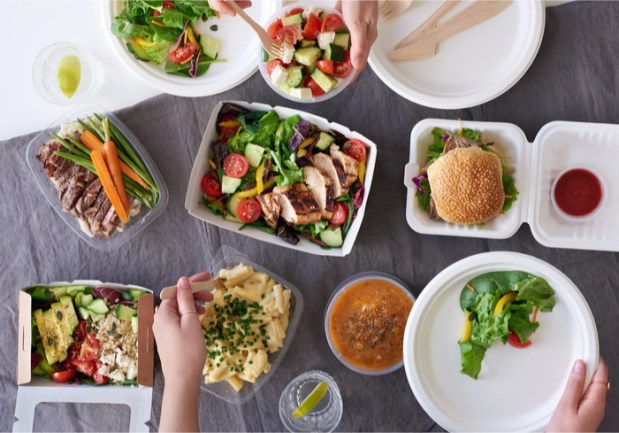Grubhub’s Latest Push: College Students And Meal Vouchers

Grubhub — fueled by a 67 percent year-over-year increase in active diners in the third quarter, as well as its recent partnership and acquisition deals — said it will boost its marketing and delivery spend this year. The plans comes as the online food delivery service positions itself as what can arguably be called an Amazon for restaurants. And the coming investments happen as the online food delivery service is aiming to win more consumer loyalty and revenue via college students.
On Thursday (Oct. 25), the online food delivery service released its Q3 earnings and said it had 16.4 million diners during that period. Daily active orders grew 37 percent to 416,000. Revenue increased 52 percent year over year to $247.2 million, beating analyst expectations. Net income increased 75 percent to $22.7 million.
In large part, the story of Grubhub’s Q3 results in a story of how its recent deals are starting to pay off.
More Investment
The company’s Q3 “momentum” will lead to Grubub “opportunistically investing an incremental $20 million to $30 million in marketing and delivery expansion in the fourth quarter, taking our total 2018 investment in growth to substantially more than $200 million,” said Adam DeWitt, Grubhub’s president and CFO. That spending will go toward such areas as digital, TV and promotional offers.
He said that Grubhub “acquired more diners at a lower cost and stable quality, despite spending roughly 60 percent more on advertising than the prior year. This strength in new diner acquisition was broad from our most mature markets to our newest.”
Grubhub serves some 180 delivery markets now, and plans to have 200 total by year’s end, he said. “The total investment associated with providing sufficient driver capacity in these additional launch markets will be approximately $10 million in the fourth quarter,” he said. “The fourth quarter is typically our strongest for new diner acquisition because of weather and school schedules.”
In the third quarter of 2018, Grubhub “added more new restaurants to our network in the third quarter than any other quarter in the history of Grubhub,” CEO Matthew Maloney told analysts during the Q3 results conference call on Thursday.
Yum! Payoff
The company’s fresh partnership with Yum! Brands also is paying off, and is now active in some 100 markets, which will lead to more investment in delivery to take advantage of that demand. Maloney said, “Our diners now have over 95,000 restaurants to choose from, including several thousand Taco Bell and KFC locations, which have joined our platform over the last couple of months.”
Grubhub recently announced a deal with Blue Apron, by which a rotating selection of meals from that company will be available on demand to customers in select areas in New York City on the Grubhub online and mobile platforms. The deal also applies to Seamless online food delivery.
Before that, Grubhub announced the acquisition of LevelUp, which should expedite integration with restaurants and create a seamless diner experience in-app, online and in-store. “While the LevelUp team will continue to make progress on their own initiatives, roadmap and restaurant partnerships, they are also already building new, robust [point-of-sale (POS)] integrations for restaurants on the Grubhub platform,” Maloney said Thursday. Part of Grubhub’s 49 percent year-over-year increase in technology spending — to $21 million — was due to work for LevelUp, with the rest going for more general technology efforts.
The company also recently said it would buy Tapingo, a mobile app that focuses on the college campus market. “Imagine college students ordering on Grubhub using meal plan dollars instead of a personal credit card,” Maloney said during the call. “The acquisition of Tapingo will open up more new growth channels for us, positioning the Grubhub brand front and center in campus life for over a 500,000 active diners across 150 universities.”
Payments, too, represent an area of expansion for Grubhub. Earlier this year, it added peer-to-peer (P2P) payments provider Venmo to the Grubhub stable. With the new functionality, consumers will have an easier way to share the cost of a delivery order with friends, Grubhub said.
Amazon Dreams
As discussed in a recent PYMNTS article from Karen Webster, Grubhub’s growth and recent acquisitions make one wonder if the company will become the Amazon of restaurants. According to that article, the real play now for Grubhub, with LevelUp, is to emerge as the leading aggregator for food ordering across all the channels through which consumers might like to interact with those eating establishments: online order and delivery, online ordering for pickup and maybe even — down the road — online ordering of a place in line at fast-casual, sit-down restaurants.
In 2015, Grubhub extended its model and stepped into the delivery business, first through the acquisitions of local platforms that both enabled online ordering and offered delivery services, and later through the expansion of its own delivery capabilities — recruiting drivers and building out tools to support the delivery side of its business.
In February of 2018, Yum! Brands made a $200 million investment in Grubhub, in part, to accelerate the build out of its delivery platform and to create more favorable delivery economics for its restaurant brands. Grubhub continues to grow toward that Amazon-like level as the grocery and food business, once a relative backwater, takes its place along the cutting edges of digital payments and commerce.
